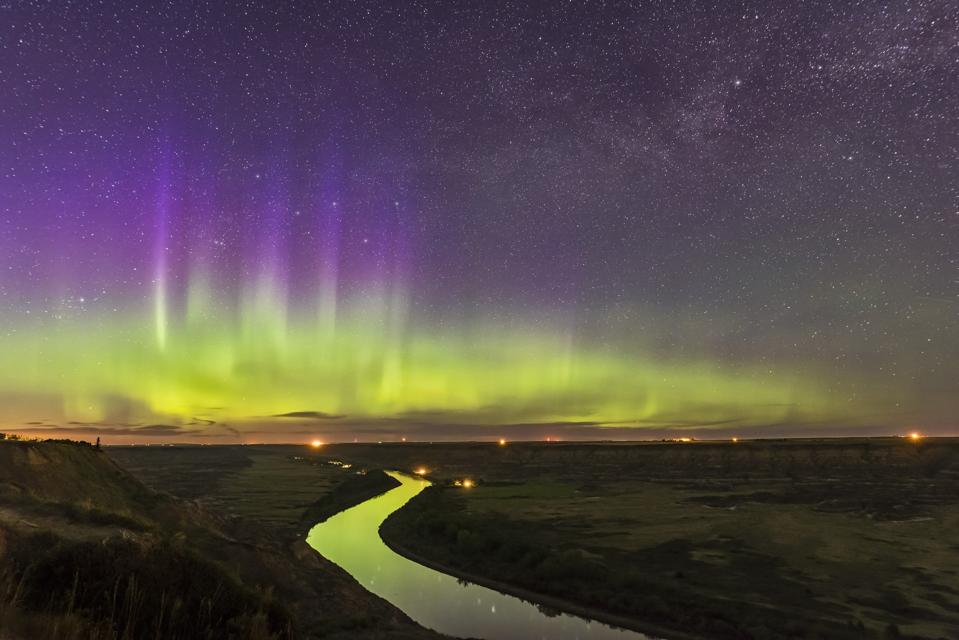The Northern Lights may be visible in the U.S. this week after a surge in solar activity. According to the National Oceanic and Atmospheric Administration’s Space Weather Prediction Center, aurora could be seen in U.S. states Tuesday and Wednesday thanks to a G2-rated geomagnetic storm resulting from two coronal mass ejections on the sun. It comes as two meteor showers are due to start this week.
The latest forecast is for a geomagnetic storm this week, with a “moderate” G2 geomagnetic storm striking on Wednesday, April 16, with aurora displays possible in northern U.S. states and Canada. The geomagnetic storm on May 10, 2024, which saw aurora as far south as Florida, was rated a G5 and was the most powerful since 2003.
Where To See The Northern Lights In The U.S. This Week
A separate prediction for aurora viewlines has almost all of Canada, save for Atlantic Canada, having a very high likelihood of aurora on Tuesday, April 15. A total of 17 U.S. states have a chance of seeing the aurora on the northern horizon, with Alaska and those on the U.S.-Canada border having a higher chance.
Two coronal mass ejections — clouds of super-charged particles — were produced. It’s these that could cause disturbances in Earth’s magnetic field later this week. CMEs travel to Earth over the course of a few days. “The CMEs are expected to reach Earth on April 16, a one-two punch sparking G2-class geomagnetic storms,” reports SpaceWeather.com.
The Kp index — which provides a rough guide to the intensity of aurora displays — may reach 6, which will see the auroral oval stretch farther south. Kp 6 equates to a G2-class geomagnetic storm. According to NOAA, for a Kp in the range of 6 to 7, the aurora can be “bright and active,” and it may be “possible to see the aurora from the northern edge of the United States.”
The 17 U.S. States That Could See Aurora This Week
Parts of U.S. states that could potentially see aurora, according to NOAA, include Alaska, Washington, northern Oregon, northern Idaho, Montana, Wyoming, North Dakota, South Dakota, Minnesota, northern Iowa, Wisconsin, northern Illinois, Michigan, New York, Vermont, New Hampshire and Maine. Areas far from light pollution are likely to get the best views.
When To See Aurora In The U.S. This Week
Exactly when and where aurora becomes visible this week will be down not to predictions, but data coming in from NASA’s DSCOVR and ACE satellites — situated about a million miles from Earth — that a roughly 30-minute warning can be given. It measures the solar wind’s speed and magnetic intensity, which is critical in calculating how it is about to change. Check NOAA’s 30-minute forecast or use the Glendale App.
What’s Causing This Display
The Northern Lights are caused by the solar wind, a stream of charged particles from the sun interacting with Earth’s magnetic field. Last weekend saw a surge in solar activity, with eight M-rated solar flares — an intense burst of electromagnetic radiation — between Friday and Monday. Solar flares travel at light speed and fuel the solar wind throughout the solar system but do not cause aurora. Unusually, these solar flares didn’t come from sunspots, dark patches on the sun’s surface indicating intense magnetic activity.
Instead, they resulted when two magnetic filaments detached from the sun. Magnetic filaments were described as “long tubes of dense plasma held above the sun’s surface by magnetic forces,” by SpaceWeather.com, which reported that they became unstable “twice in quick succession on April 12th and 13th—a rare double blast.” Crucially, following the solar flares and the exploding filaments, two CMEs were produced.
Wishing you clear skies and wide eyes.

